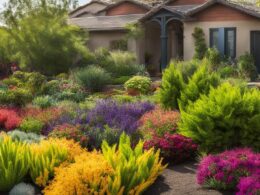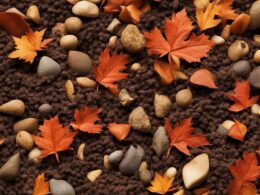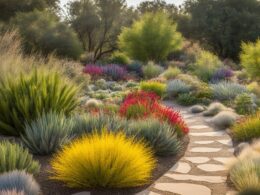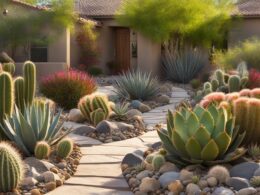Welcome to the world of xerogardening, a sustainable landscaping practice that focuses on creating beautiful gardens with minimal water requirements. By carefully selecting native plants and incorporating drought-tolerant landscaping techniques, you can create a vibrant and eco-friendly garden that thrives even in water-scarce environments. In this article, we will explore the benefits of xerogardening, the planning and designing process, the ideal plant species for xerogardens, and more.
Key Takeaways:
- Xerogardening focuses on designing gardens with minimal water requirements.
- By selecting native plants, you can create a sustainable garden that thrives in the local climate.
- Benefits of xerogardening include water conservation, cost savings, low maintenance, and attracting native fauna.
- Planning and designing a xerogarden involves soil analysis, plant selection, grass reduction, zoned irrigation, soil protection, and landscaping with stones.
- Xerogardens emphasize the use of drought-tolerant plant species, such as xerophytes.
Advantages of Xerogardening
Xerogardening offers several advantages for homeowners who are looking to create sustainable and low-maintenance landscapes. By embracing xerogardening techniques, you can enjoy the following benefits:
- Water Conservation: Xerogardens are designed to minimize water usage, reducing consumption by up to 80% compared to traditional gardens. This not only helps preserve valuable water resources but also leads to significant cost savings on water bills.
- Cost Savings: With xerogardening, you can save money on maintenance. These gardens require less watering, mowing, and fertilizing, resulting in lower maintenance costs over time. Additionally, the use of native plants in xerogardens eliminates the need for expensive pest control and fertilizers, further reducing expenses.
- Low Maintenance: Xerogardens are designed to be drought-resistant and require minimal care. Once established, they can thrive with little to no additional watering, reducing the need for constant maintenance and allowing you to spend more time enjoying your garden.
- Drought Resistance: Xerogardens are built to withstand drought conditions. By selecting native and drought-tolerant plants, you can ensure that your garden remains vibrant and resilient even during periods of water scarcity.
- Native Fauna: Xerogardens that incorporate native plants play an essential role in supporting local wildlife. Native flora attracts native fauna, including bees, butterflies, and birds, enhancing biodiversity and creating a thriving ecosystem in your garden.
By embracing xerogardening and harnessing its numerous advantages, you can create a beautiful and environmentally friendly landscape that not only enhances your property but also contributes to water conservation efforts and promotes the well-being of local wildlife.
Testimonial:
“Since I transformed my garden into a xerogarden, I’ve noticed a significant reduction in my water bills. Not only that, but I spend less time maintaining the garden and can now enjoy its beauty all year round. The native plants have attracted butterflies and birds, making my garden a vibrant haven for wildlife.” – Jane Doe, xerogarden enthusiast
Planning and Designing a Xerogarden
Planning and design play a crucial role in creating a successful xerogarden. By following a few key steps, you can ensure that your xerogarden thrives while minimizing water usage and maintenance. Let’s explore the key considerations for planning and designing your xerogarden.
Selecting the Right Plants
The first step in planning your xerogarden is conducting a soil analysis. By understanding the characteristics of your garden soil, such as texture, pH, drainage, and fertility, you can choose plants that are well-suited to thrive in your specific conditions. Native plants are often an excellent choice for xerogardens as they are naturally adapted to the local environment and require less water.
When selecting plants for your xerogarden, consider reducing lawn areas and incorporating drought-resistant grasses. Instead, opt for a mix of ornamental plants, native shrubs, and groundcovers. This diverse selection will not only add visual interest but also provide a habitat for local fauna.
Zoned Irrigation and Soil Protection
To ensure efficient water use in your xerogarden, consider implementing zoned irrigation. Group plants with similar water requirements together and install an irrigation system that delivers water specifically to those zones. This targeted approach prevents water wastage and promotes the health of your plants.
Soil protection is another crucial aspect of xerogarden design. Apply a layer of organic mulch, such as straw, dry leaves, or tree bark, to retain moisture, suppress weed growth, and keep the soil cool. This layer acts as a protective barrier, reducing evaporation and erosion.
Enhancing the Design with Stones
Landscaping with stones can add an aesthetically pleasing element to your xerogarden’s design. Stones provide a low-maintenance ground covering that complements the drought-resistant plants. You can use stones to create pathways, borders, or decorative features, adding texture and visual appeal to your xerogarden.
By considering factors such as soil analysis, plant selection, grass reduction, zoned irrigation, soil protection, and landscaping with stones, you can effectively plan and design your xerogarden. These strategies will maximize water efficiency and create a beautiful, sustainable garden that thrives in the face of drought conditions.
Plant Species for Xerogardens
Xerogardens are designed to thrive with minimal water usage, making the selection of plant species a crucial aspect of their success. By choosing xerophytic plants, which are specifically adapted to dry climates and have low water requirements, you can create a beautiful and sustainable garden. Here are some examples of plant species that are well-suited for xerogardens:
Trees
- Acacia
- Cercis
- Olive
- Fig
- Jacaranda
- Eucalyptus
Shrubs
- Rockrose
- Cotoneaster
- Hibiscus
- Plumbago
Groundcovers
- Caper
- Felicia
- Maiden Grass
Climbers
- Bougainvillea
- Ivy
- Asparagus
These plant species exhibit characteristics such as fleshy leaves, water storage capabilities, and deep root systems, enabling them to survive in dry environments. When choosing plants for your xerogarden, it is recommended to prioritize native species or those with similar climate requirements. Native plants have already adapted to the local environment and are more likely to thrive with minimal water usage.
Keep in mind that the selection of plant species should also take into account factors such as the desired aesthetics, growth habits, and compatibility with other plants in your garden. By carefully choosing the right mix of xerophytic trees, shrubs, groundcovers, and climbers, you can create a visually appealing and sustainable xerogarden that thrives in a water-efficient manner.
Creating a xerogarden requires thoughtful planning and consideration. By incorporating xerophytic plant species that are well-adapted to dry environments, you can achieve a beautiful and sustainable landscape that conserves water and requires minimal maintenance. So, whether you’re looking to transform your existing garden or starting from scratch, consider embracing xerogardening and enjoy the benefits of a water-efficient and environmentally friendly outdoor space.
How Can Native Plant Selection Maximize the Benefits of Xerogardens?
When planning a xeriscape garden design with native species, it’s essential to carefully consider native plant selection. Choosing drought-tolerant plants that are adapted to the local climate and soil conditions will help maximize the benefits of xerogardens, such as water conservation, reduced maintenance, and support for local wildlife.
Conclusion
Xerogardening offers an environmentally friendly and sustainable approach to landscaping, particularly in areas prone to drought or with limited water resources. By selecting native or well-adapted plant species, you can create beautiful, water-efficient gardens that require minimal maintenance.
Xerogardens not only conserve water but also support local flora and fauna, reduce the use of fertilizers and pesticides, and provide cost savings. By following the principles of xerogardening, such as proper plant selection, zoned irrigation, and soil protection, you can maximize the potential of your xerogardens and enjoy a thriving, sustainable garden.
With careful planning and design, xerogardens can be both aesthetically pleasing and environmentally responsible, showcasing the beauty and resilience of native and drought-tolerant plants. Embrace xerogardening to create a water-efficient and visually appealing landscape that promotes sustainability and drought resistance.












